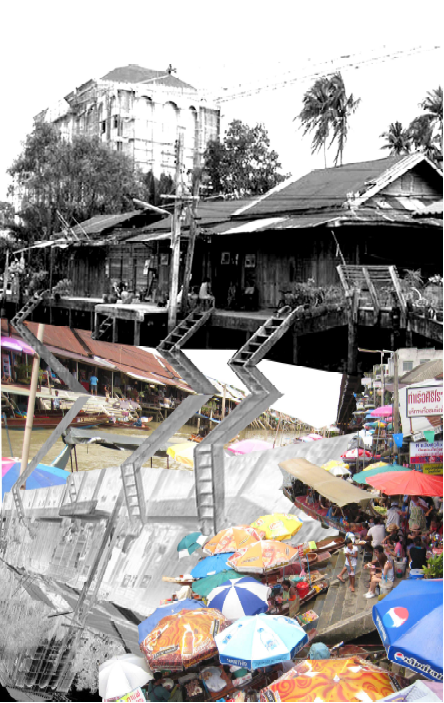Place and identity processes: remarks from Thailand fieldworks on gentrification
Main Article Content
Abstract
In Thailand, place and identity processes, and gentrification are two relevant aspects rarely problematized in urban conservation and development. Replacement by newcomers matches the definition of gentrification when their thinking and living patterns disrupt the local ways of life and affect the neighborhood’s identity on both physical and social characteristics entwined into the place making. Collective fieldwork experience of the authors combining the cases of Banglamphu in Bangkok old town and Amphawa in Samut Songkram province led to the analysis of values and meanings of cultural environment and heritage significantly impacted by tourism and conservation driven gentrification. The site surveys sectioned the psychological environment variables derived from the place and identity processes into three main parts: (1) place distinctiveness, (2) place continuity, and (3) self-esteem/efficacy. Suggestions targeting urban planners and decision makers or stakeholders in tourism regeneration and conservation-led development planning are; (1) Identification of an area, in which its name and boundary do not concur with government’s administrative approach, affecting on management of cultural heritage place, (2) The matter of small things and intangible or lost values that have become vivid cultural memories and should be cautiously considered for tourism usages, and (3) Impacts from development projects towards the local everyday life, which keep pushing and alienating people from their own place.
Article Details

This work is licensed under a Creative Commons Attribution-NonCommercial-NoDerivatives 4.0 International License.
References
Appleyard, D. (1979). The conservation of European cities. Cambridge: MIT Press.
Butler, R.W. (1980). The concept of a tourist area cycle of evolution: implications for management of resources. The Canadian Geographer, 24(1), 5–12.
Creswell, J.W. (1994). Research design: qualitative and quantitative approaches. London: Sage Publications.
Gotham, K.F. (2005). Tourism gentrification: the case study of New Orlean’s Vieux Carre (French quarter). Urban Studies, 42(7), 429-452.
He, S. (2007). State-sponsored gentrification under market transition. Urban Affairs Review, 43(2), 171-198.
Herzfeld, M. (2017). Playing for/with time: tourism and heritage in Greece and Thailand. In Gravari-Barbas, M. & Guinand, S. (Ed.). Tourism and gentrification in contemporary metropolises: international perspectives (pp.233-252). London: Routledge.
Huyakorn, Y.C. (2017). Exploring Chiang Mai through gentrification lens: drawing linkage between tourism and social class changes of residents in the old city. Journal of Social Sciences, Faculty of Social Sciences, Chiang Mai University, 29(2), 73-101.
Lees, L., Slater, T. & Wyly, E. (2008). Gentrification. London: Routledge.
Office of Environmental Policy and Planning. (1997). Phaenmaebot phuea karn anurak lae pattana krung rattanakosin. (In Thai) [Master plan for conservation and development of Bangkok historic quarters]. Bangkok: Office of Environmental Policy and Planning.
Office of Natural Resources and Environmental Policy and Planning. (2005). Phaenthi lang singwaetlom thang wattanatham, changwat Samut Songkhram. (In Thai) [Cultural environment atlas, Samut Songkhram province]. Bangkok: Office of Natural Resources and Environmental Policy and Planning.
Pokharatsiri, J. (2003). Karnsueksa prakotkan gentrification nai karnanurak chumchon mueang: koranee phonkrathob thang sangkhom nai yarn chumchon Banglamphu, Krungthepmahanakhon. (In Thai) [Towards gentrification in urban conservation: the case of social impacts in Banglamphu area, Bangkok] (Master’s thesis). Bangkok: King Mongkut’s Institute of Technology Ladkrabang.
Pokharatsiri, J. (2011). Assessing social value in cultural heritage place: a case study of tourism gentrification in Thailand in its regional context (Doctoral dissertation). Oxford: Oxford Brookes University.
Pokharatsiri, J. (2012a). Karn thopthuan tuachiwat pramoen khunkha choeng khunnaphab phuea rabu panha sonren nai singwaetlom watthanatham khong chumchon. (In Thai) [A review of qualitative value-assessment indicators to identify hidden cultural environment problems in local communities]. Built Environment Research Associates’ Conference (BERAC 3) (pp.103-114). Bangkok: Faculty of Architecture and Planning, Thammasat University.
Pokharatsiri, J. (2012b). Bangkok old town in dissonance: heritage, tourism and gentrification. NAJUA Journal of Faculty of Architecture, Silpakorn University, 9, 120-135.
Prakitnonthakan, C. (2021). State-led gentrification nai yarn kao Krungthepmahanakhon (1). (In Thai) [Sate-led gentrification in old quarters of Bangkok (1)]. Retrieved July 28, 2021, from https://www.matichonweekly.com/column/article_446657
Royal Gazette. (2013). Ministerial regulation of Bangkok comprehensive plan B.E. 2556 [Picture]. N.P.: Author.
Royal Gazette. (2017). Ministerial regulation of Amphawa, Samut Songkhram province, comprehensive plan B.E. 2560 [Picture]. N.P.: Author.
Ruengwes, P. (2023). Chiang Mai x digital phanechon. (In Thai) [Chiang Mai x digital nomad]. Retrieved January 18, 2023, from https://readthecloud.co/digital-nomad-chiang-mai/
Sanoff, H. (2000). Community participation methods in design and planning. New York: Wiley.
Twigger-Ross, C.L. & Uzzell, D.L. (1996). Place and identity processes. Journal of Environmental Psychology, 16(3), 205-220.
Visetpricha, B. (2021). Karn plaengplian chonchan khong yarn nai mueang duay kho ang darn singwaetlom lae ladthi amnatniyom choeng niwet wittaya: karn fuenfu khlong phai tai rattaban thahan nai prathet Thai. (In Thai) [Environmental gentrification and eco-authoritarianism: restoring canals under the military-led government in Thailand]. Retrieved March 31, 2021, from https://kyotoreview.org/issue-30/environmental-gentrification-and-eco-authoritarianism-restoring-canals-under-the-military-led-government-in-thailand-th/


